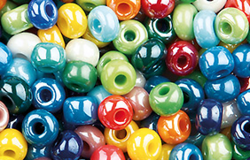Beads for a Bracelet
 The beads for a bracelet are spheres of radius of 5mm with a hole of radius 3mm drilled through the center so that they can be threaded together.
The beads for a bracelet are spheres of radius of 5mm with a hole of radius 3mm drilled through the center so that they can be threaded together.
What is the volume, in mm 3 , of material removed from the bead when the hole is drilled?
[Give your answer to 3 decimal places]
The answer is 255.516.
This section requires Javascript.
You are seeing this because something didn't load right. We suggest you, (a) try
refreshing the page, (b) enabling javascript if it is disabled on your browser and,
finally, (c)
loading the
non-javascript version of this page
. We're sorry about the hassle.
2 solutions
Maybe you should state that you want to volume in m m 3
Is it possible to immediately calculate the inner part that was removed? I did it this way, but it didn't work.
Let the bead be the area x = sqrt( 25-y^2) revolved around the y-axis. Then, calculate the integral of pi*x^2 with respect to dy, and use the upper and lower bounds 3 and -3.
Any idea why this doesn't work?
Log in to reply
Your approach or finding the volume of the inner part will work.
I think you made a mistake in your calculations, but I cannot be sure. Can you write it out fully?
I solved this question in under 30 seconds!!! Actually, the "drilled sphere" or "bead" is called a "napkin ring". The interesting part is: Volume of all napkin rings of equal height is equal. In this case, the height is 4mm. So the volume of remaining part is (4/3)pi(4)^3.
We want to integrate over the bottom of the cylinder, so our goal is something like ∫ 0 r ∫ 0 2 π f ( r , ϕ ) d ϕ d r with the radius of the cylinder r and the angle ϕ .
So, first off we need a value for the height z. The parameterisation of a sphere is { ( x , y , z ) ∈ R 3 : x 2 + y 2 + z 2 ≤ R 2 } with R bing the radius of the sphere. From this parameterisation follows z ( x , y ) = R 2 − ( x 2 + y 2 ) .
Now we have everything we need: V = 2 ∫ A z ( x , y ) d x d y with the over all volume V (the factor 2 needs to be added because we only calculate half of the volume with the integral - the origin of our coordinate system is in the centre of the sphere).
Now we can change the integral to cylindical coordinates according to the conventions of Wikipedia and we get: V = 2 ∫ 0 r ∫ 0 2 π r R 2 − r 2 d ϕ d r
This calculation can be solved by substituting (for example) R 2 − r 2 = u .
Solving everything we get the value V = 2 5 5 . 5 1 6 m m 2 .
The volume of the 5mm sphere is 3 4 π ( 5 ) 3 = 3 5 0 0 π .
Envision the bead as the area between the curves y = 2 5 − x 2 and y = 3 revolved around the x -axis. Using the Washer Method , this volume will be given by
π ∫ − 4 4 ( 2 5 − x 2 ) 2 − ( 3 ) 2 d x = π ∫ − 4 4 1 6 − x 2 d x = 3 2 5 6 π
Subtracting this result from the total volume gives the amount of material removed by the drill:
3 5 0 0 π − 3 2 5 6 π = 3 2 4 4 π ≈ 2 5 5 . 5 1 6 mm 3 . □